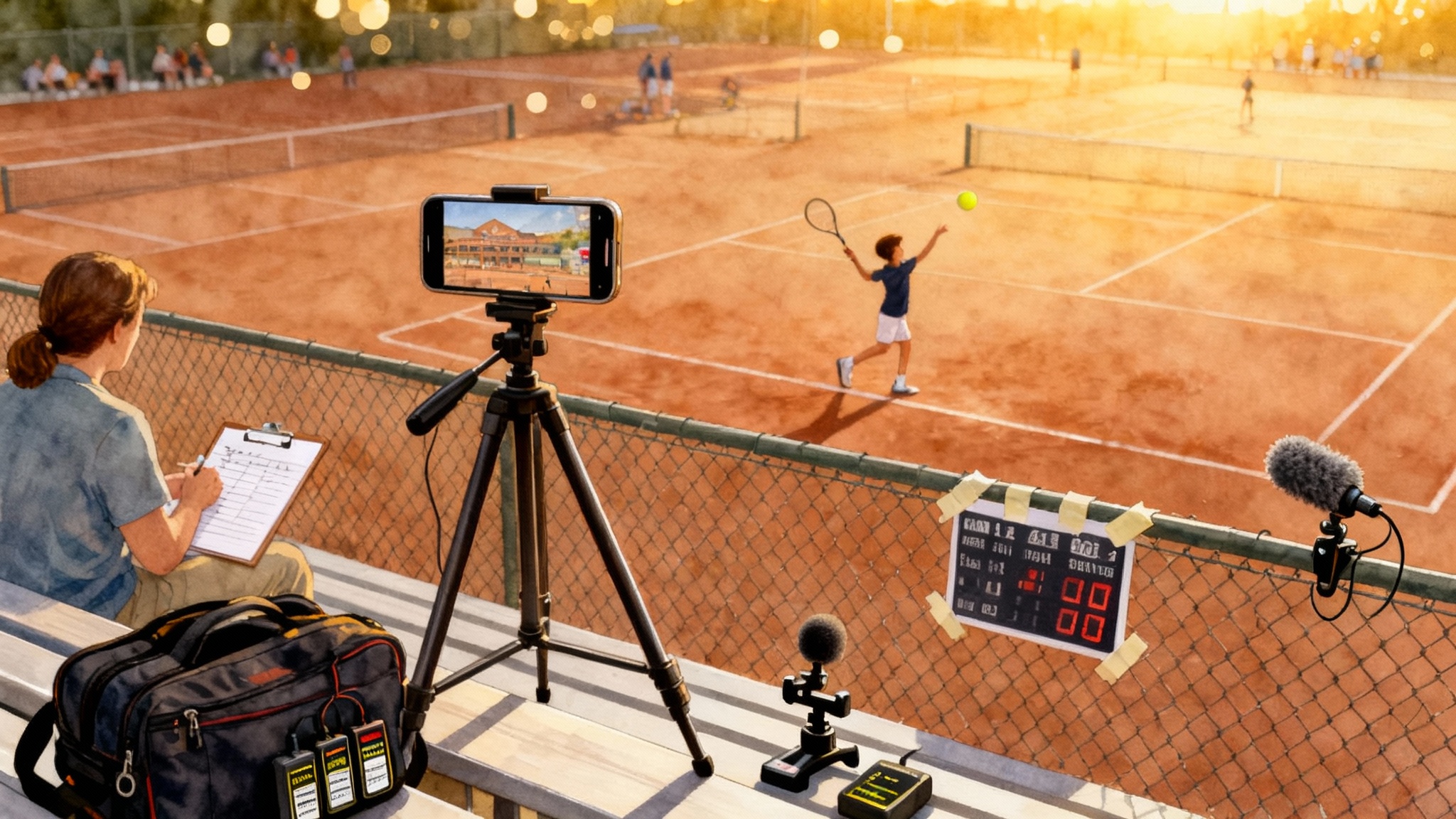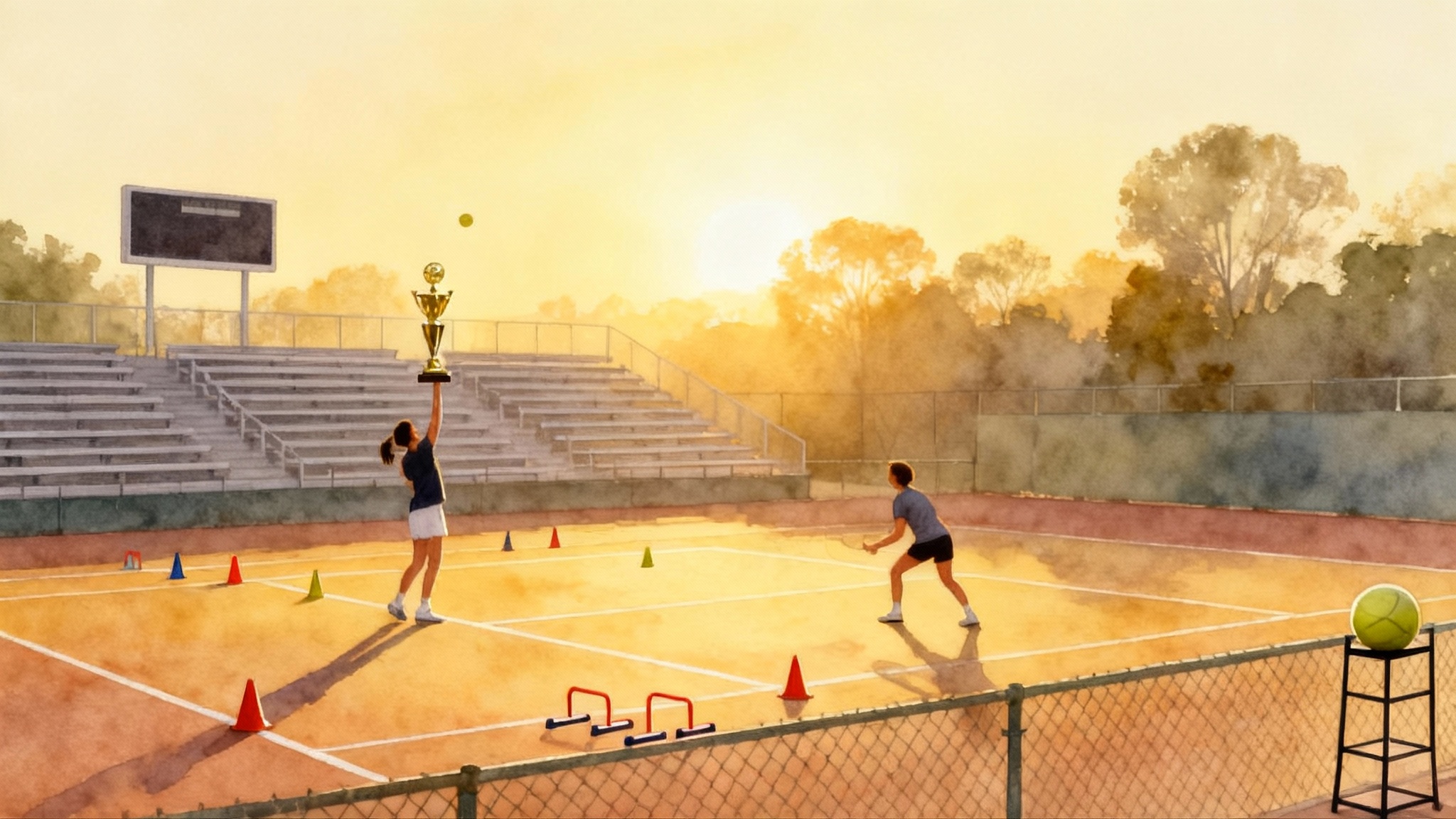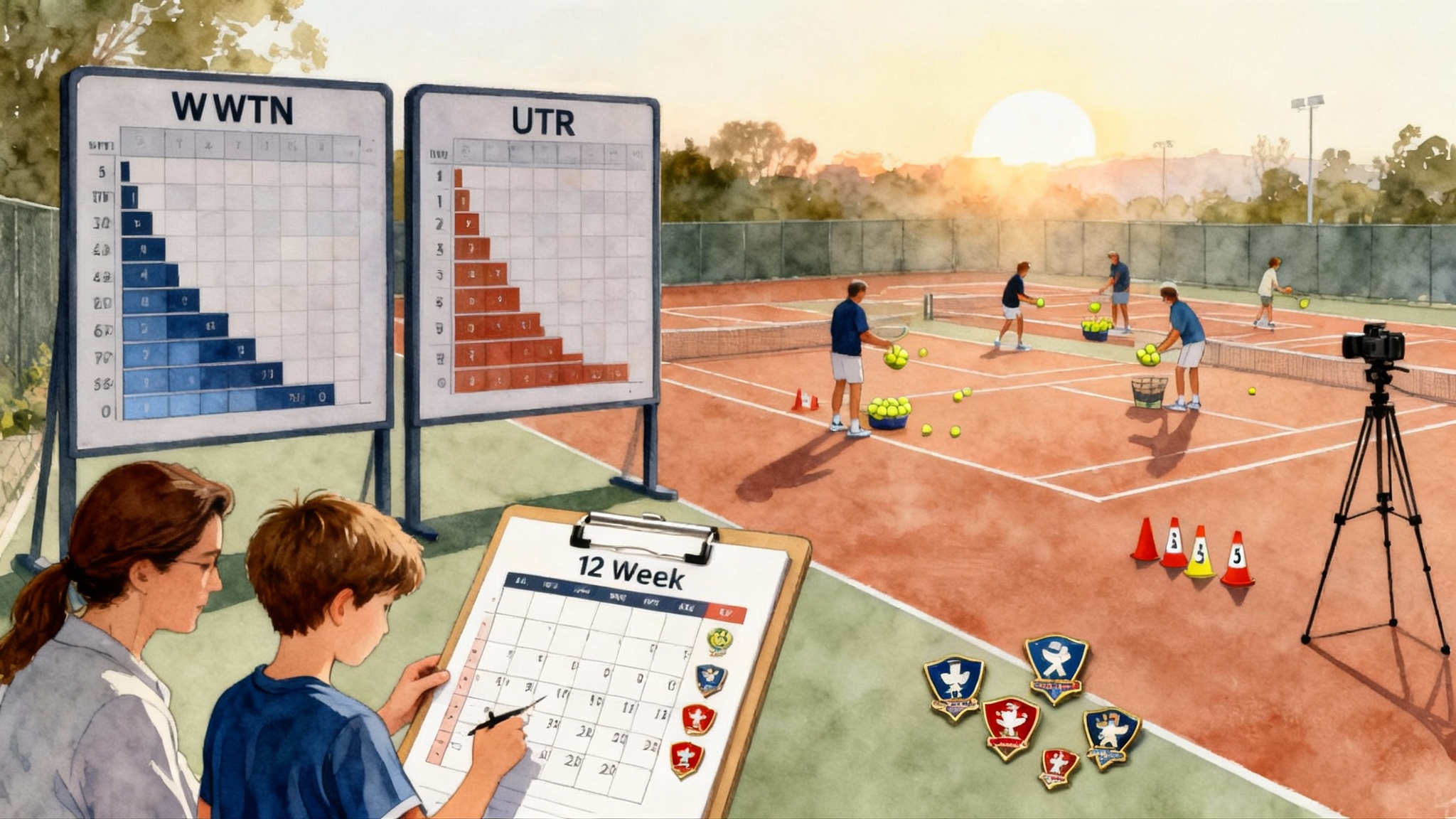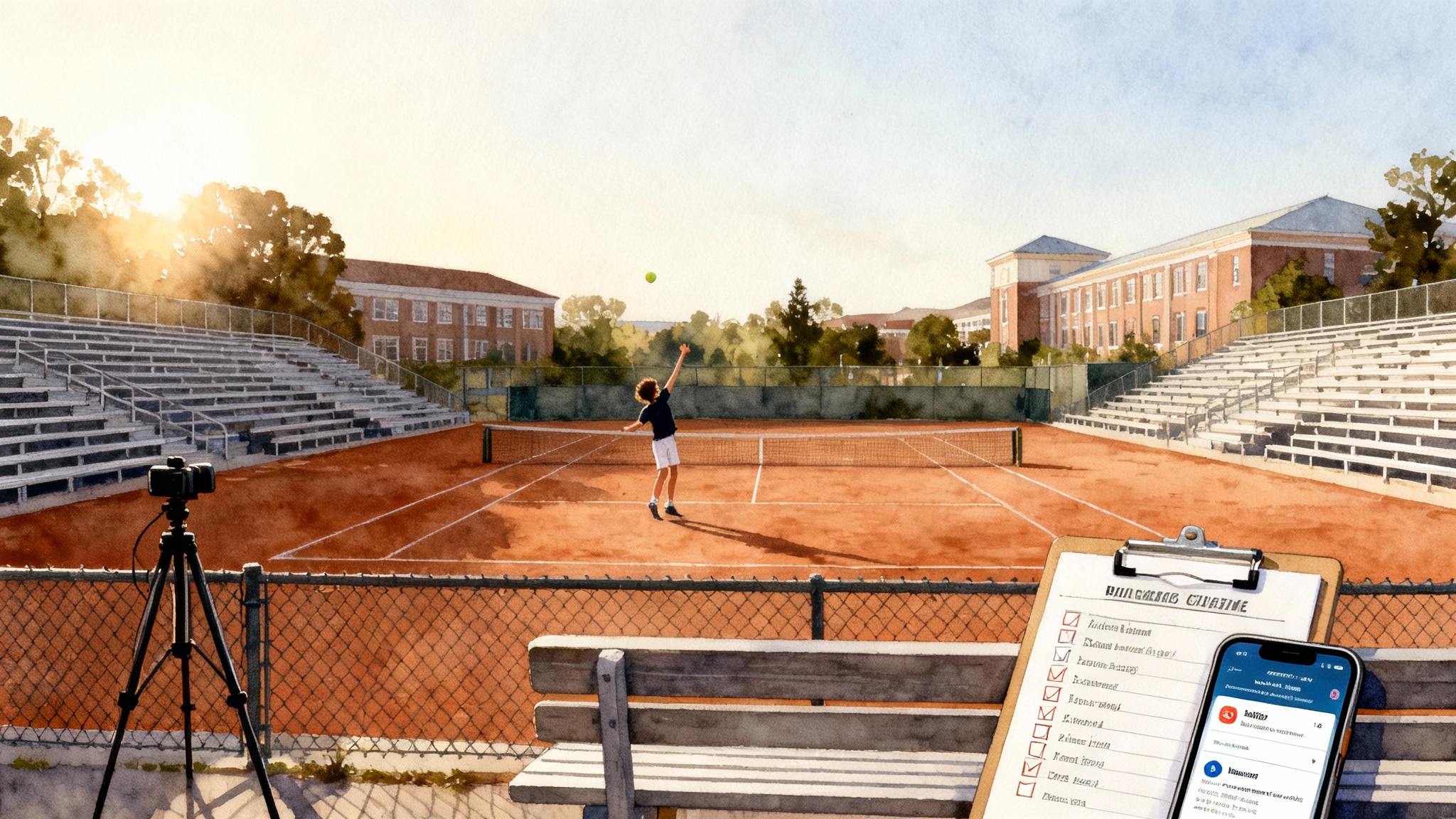College Tennis Recruiting Video 2025: 3-Minute Reel Guide
A practical, parent-friendly toolkit to plan, film, edit, and share a three-minute recruiting reel that college tennis coaches actually watch. Exact shot list, camera settings, doubles musts, privacy tips, and ready-to-send emails.

The three-minute reel coaches actually watch
You do not need a film degree or a cinema camera to create a college-ready tennis highlight. You need a plan, the right angle, clean sound of the ball, and evidence you can win real points. This step-by-step toolkit walks U.S. juniors and parents through exact shots, angles, settings, doubles specifics, how to tailor clips by UTR and WTN, and how to share the reel privately with coaches on a follow-up cadence aligned to the NCAA calendar.
Your 3-minute blueprint
Target length: 3:00. Keep every clip intentional. Here is the structure that holds a coach’s attention from start to finish.
- 0:00-0:07 Title slate: Name, grad year, city, hand, height, dominant patterns, UTR and WTN, email and phone. Example: Jordan Lee, 2027, right-handed, 5’10”, heavy topspin forehand, UTR 9.8, WTN Singles 21.4, doubles WTN 20.1, jordan.lee@email.com, 555-123-4567.
- 0:07-0:12 Warm opener: One clean point won on serve and one on return. Show decision making, not just winners.
- 0:12-2:12 Match play sequence: 8 to 12 points from recent tournament matches against known competition. Mix serve, return, neutral, defend, finish. Keep each rally 8 to 20 seconds. Include score bug in the corner.
- 2:12-2:42 Focused drills: 30 seconds total. Two drills that map to match patterns you actually use, such as cross-court forehand pattern then line change, or serve plus first ball.
- 2:42-2:58 Doubles actions: 16 seconds total. One point showing your serve team formation and one return game with a proactive poach.
- 2:58-3:00 End slate: Contact info again and upcoming schedule window for calls or visits.
Why this works: coaches want to see what translates to college lineups. Match points prove it under pressure. A short drill section shows specific skills in isolation without turning the reel into a practice montage.
Exact shot list coaches expect
Record more than you will use, then trim mercilessly.
Singles must-haves
- Two serve points on deuce, two on ad. Mix first and second serve. Include a body serve.
- Two return points against first serves and two against second serves. Show neutralizing returns.
- One rally that shows high ball tolerance, 8 or more balls struck.
- One defend-to-attack pattern. Example: stretch backhand slice to reset, then take forehand early.
- One approach plus volley finish. If you are a baseliner, choose the best example you have.
- One point where you lose the point but make the right decision. Coaches care about process.
Doubles must-haves
- One point using I-formation with a clear signal and a purposeful move.
- One Australian formation point to show return adaptation.
- One return game with a drive return cross and your partner’s first-volley competence.
- One serve-plus-two pattern at the net, including an overhead.
- One active poach that starts early, not a last-second lunge.
The only two camera angles you need
- Primary match angle: High and centered behind the baseline. Elevate 8 to 10 feet, 3 to 5 feet behind the fence, lens centered on the center mark. This angle shows depth, spin, and court positioning clearly.
- Secondary side angle: Mid-court height on the doubles alley, lens aimed diagonally to the opposite service line. Use sparingly for serves or footwork emphasis.
Pro tip: If you cannot elevate, step back from the fence and zoom a little to compress the chain link pattern. A simple fence clamp with a mini ball head is worth its cost.
Phone and mirrorless settings that keep the ball sharp
Smartphone settings
- Resolution and frame rate: 1080p at 60 frames per second. If your phone handles it reliably, 4K at 60 frames per second is excellent but produces large files.
- Shutter: Use an app with manual controls if possible. Target 1/120 s at 60 fps. In bright sun, increase to 1/240 s to freeze the ball.
- Exposure and focus: Tap to focus on the baseline, then lock exposure and focus to prevent pulsing. Slight underexposure holds detail in bright courts.
- Stabilization: Turn on optical stabilization. Avoid aggressive digital stabilization that warps lines.
- Audio: Wind reduction on. Ball sound matters.
Mirrorless settings
- Resolution and frame rate: 1080p or 4K at 60 fps.
- Shutter: 1/120 s minimum. Go faster if the ball blurs.
- Aperture: f/5.6 to f/8 to keep both baselines sharp.
- ISO: Auto with a ceiling of 1600. Noise is better than blur.
- White balance: Daylight preset outdoors. Lock it.
- Lens: 24-70 mm on full frame, 18-55 mm on APS-C. Start around a 35-50 mm equivalent from an elevated baseline.
Accessories that help
- Fence clamp or tall tripod, two charged batteries or power bank, 128 GB card, microfiber cloth, small gaffer tape for the on-fence score bug.
Match play vs drills: the right ratio
A strong reel is 70 to 80 percent match play and 20 to 30 percent focused drills. If you have limited match footage, show fewer drills, not more. Coaches value the repeatability of patterns under pressure. A drill clip should demonstrate a tool that appears in your match points, not an isolated trick shot.
Good drill picks
- Serve plus first ball cross then inside-in.
- Backhand cross for three balls then line change.
- Approach off a short ball and a first volley to deep middle.
- Doubles hand battles from 10 feet at the net with controlled pace.
Tailor your reel by UTR and WTN band
Use UTR by Universal Tennis and the International Tennis Federation’s World Tennis Number as context, not decoration. Coaches already use both. For a deeper primer on how the two systems compare and how coaches view them, see our WTN vs UTR 2025 guide. The ITF explains the 40-to-1 scale and weekly update cadence in its World Tennis Number overview.
Guidance by current level
- UTR 10 and above or WTN singles 1 to 15: Emphasize match points versus nationally ranked opponents. Include two problem-solving rallies where you extend the point, not just first-strike winners. Add one point returning a heavy first serve.
- UTR 7 to 9.9 or WTN singles 16 to 25: Show clean technique and athletic movement with fewer unforced errors. Include one clip where you defend a high-heavy ball and reset. Add a doubles poach to highlight hands.
- UTR below 7 or WTN above 25: Prioritize clarity and consistency. Show full-court patterns and decision making. Keep drills simple and show stable contact and balanced recovery. Include two returns that start neutral.
Note on doubles WTN: If your doubles WTN is materially stronger than singles, consider a separate 90-second doubles reel linked in your email, and keep a 15 to 20 second doubles section in the main reel.
Editing that respects a coach’s time
Keep it clean, audible, and labeled.
- Trim dead time: Cut between points quickly. Leave the bounce and hit sounds intact.
- No music. Ball and footwork audio help coaches assess timing. If you need movement quality, improve it at practice with this two-session split-step timing made simple.
- On-screen labels: Simple lower-left captions with player in color and opponent in white, tournament name and round, date, and score at the start of each point. Example: USTA L4, Round of 16, Aug 2025, Score 2-1 30-15.
- Chapters: Add YouTube chapters or Vimeo markers for sections like Serve, Return, Defense, Net.
- Color and audio: Minor exposure and color balance fixes only. No heavy looks. Normalize audio to consistent loudness.
- Export: 1080p or 4K, 60 fps, H.264, 12 to 20 Mbps for 1080p and 35 to 50 Mbps for 4K.
File naming, captions, and thumbnails
- File name: Lastname_Firstname_GradYear_UTRWTN_City_State_Version.mp4. Example: Lee_Jordan_2027_UTR9.8_WTNS21.4_NY_v1.mp4.
- Video description: First three lines must include your name, grad year, UTR and WTN, best contact, and upcoming live schedule. Add your coach’s contact and link to a tournament profile if you have one.
- Timestamps: 00:00 title slate, 00:07 openers, 00:12 match points, 02:12 drills, 02:42 doubles, 02:58 end slate.
- Thumbnail: A wide shot where both baselines are visible, no text, no effects.
YouTube or Vimeo privacy settings that work
- Use Unlisted, not Private. Private blocks coaches. Unlisted lets you email a clean link without it being public.
- Turn off comments and ads to reduce distractions.
- Enable embedding so your link previews in email and on a recruiting portal.
- Add chapters and a short description with contact and schedule at the top.
- If using Vimeo, a password is fine, but include it in the first line of your email and in the video description.
NCAA recruiting timing and your follow-up cadence
For most sports including tennis, Division I direct recruiting communication begins June 15 after the sophomore year, with visits and off-campus contact allowed starting August 1 before the junior year. See the NCAA’s first-contact timeline for details.
Build your cadence around two realities:
- Before June 15: You can email coaches updates, but coaches cannot reply directly. You are building a file.
- After June 15 and after August 1: Coaches can respond, call, and schedule visits based on your grad year.
A simple four-week cadence
-
Day 0 initial send: Subject examples
- 2027 righty with UTR 9.8 and WTN 21.4
- 2026 doubles first with WTN 18.9 and fall schedule
Email body template
Coach [Last Name],
My name is [Name], Class of [Year], from [City, State]. I play [right or left] handed with a [one or two] handed backhand. Current UTR [x.x]. WTN singles [xx.x], doubles [xx.x]. I am interested in [School] because [one specific program detail].
Here is my 3-minute reel and recent tournament clips. I would value your feedback.
Reel: [Unlisted link]
Upcoming schedule: [Tournament name, city, dates]
Academics: [GPA, course highlights]
Thank you for your time.
[Name]
[Phone]
[Coach name and contact, if permission] -
Day 7 nudge with value: Send one match result and a 20-second clip timestamp from the same reel. Reinforce your interest with one academic or program fit detail.
-
Day 21 update: Share two upcoming events where the coach might watch live or via livestream. Offer one specific time window for a call if your contact date allows.
-
Day 28 call to action: Ask directly if your profile aligns with their 2026 or 2027 needs, and if they recommend a camp, a visit, or more match film.
Pre-June 15 version: Keep the same timeline, but remove calls to action that ask for replies. Replace with: I will send an updated link after [event]. I understand reply restrictions until June 15 after my sophomore year.
Division II and Division III note: Division II contact generally also keys off June 15 in practice, while Division III is more flexible. Always check with your high school or academy compliance contact for current specifics.
Ready-to-use email templates
Subject lines that get opened
- 2027 righty with heavy FH pattern, UTR 9.5, WTN 22.1
- 2026 lefty serve plus first ball, WTN 17.8, fall schedule inside
- 2027 doubles specialist, WTN dubs 18.4, 90-second reel
Template 1: Initial reach out
Coach [Last Name],
I am [Name], Class of [Year], from [City, State]. I compete for [High School/Academy]. Current UTR [x.x]. WTN singles [xx.x], doubles [xx.x].
My three-minute reel shows match points first, then key drills. I hope it gives you a clear view of my patterns and work rate.
Reel link: [Unlisted URL]
Upcoming schedule: [Event, city, dates]
Academics: [GPA, coursework]
I am very interested in [School] because [specific fit]. Thank you for your time.
[Name] | [Phone] | [Email]
Template 2: Post-event update
Coach [Last Name],
Quick update after [Tournament]. I went [results]. Two points I am proud of are at [mm:ss] and [mm:ss] in the reel. They show [pattern].
Next events: [Event and date]
Thank you for following my progress.
[Name]
Template 3: Visit or call request when allowed
Coach [Last Name],
Now that contact is permitted for my class year, would you have 15 minutes for a call next week between [two windows]? I would also welcome guidance on whether a fall visit makes sense.
Thank you,
[Name]
Template 4: Polite close and ask for feedback
Coach [Last Name],
I appreciate your time over the past month. If you see a potential fit, I would be excited to discuss next steps. If not, any feedback on my game and schedule would help me target appropriately.
Best regards,
[Name]
Doubles specifics that move the needle
Coaches recruit singles points and doubles pairs. Your doubles section should prove you understand modern formations and proactive net play.
- Serve team: Show I-formation with a clear pre-point signal, a quality first volley from the server’s partner, and the server covering the open lane.
- Return team: Two formations. Standard with cross return and partner ready to take the middle. Australian to push the returner down the line and trigger a poach.
- Middle first: Demonstrate that your first look is middle control, not line risk.
- Overheads and lobs: Include one overhead defend and one controlled defensive lob recovery.
Angle for doubles: Same elevated baseline angle, but slightly to the deuce side so both net players are visible.
How to capture a real match without being a distraction
- Arrive 20 minutes early to set up. Test that the entire court is in frame.
- Post a small paper score bug on the fence in frame. Update the digits between points.
- Do not talk during points. Keep the mic away from chatter and wind.
- Record full sets. You will want options.
A parent’s one-page checklist
- Gear: phone or camera, clamp or tripod, extra power, card, tape, lens cloth.
- Settings: 1080p at 60 fps, 1/120 s shutter, exposure lock, wind reduction.
- Angle: elevated baseline. Confirm no fence pattern wavering in the frame.
- Match: score bug visible, opponent name and tournament noted.
- Backup: stop every 25 minutes to save, then restart during changeover.
Common mistakes to avoid
- Endless drills. Keep them to 20 to 30 percent with a clear match connection.
- Flashy cuts. No fast strobe cuts, no heavy music, no big text boxes.
- Only winners. Include two points that show problem solving and defense.
- Low angle from the side fence. It hides depth and makes the ball look slow.
- Private video links. Coaches need instant access.
Optional sidebar: one-afternoon pro reel in Westchester
If you want a turnkey option, you can book a pro-quality filming and edit session in one afternoon at Tennis Innovators Academy in Westchester. We set the angle, capture match-play and key drills, and deliver a ready link with captions and chapters. Interested families can request dates through the academy page so we can coordinate court time and staffing.
When to add a new reel
- After a level jump, such as a two-point UTR gain or a five-point WTN improvement.
- Before key recruiting windows, such as early June and late July for summer events.
- After meaningful tournament wins against peers with known numbers.
Internal quality control before you send
- Play it on a phone and a laptop to check legibility of labels.
- Ask two adults who do not know your game to watch without audio and describe your style. If their description is not what you intend, adjust the clip order.
- Confirm the first five seconds show your name and class year. Coaches triage fast.
Why this approach aligns with what coaches need
College matches are decided by repeatable patterns, returns that start neutral, and doubles pairs that own the middle. A high, steady baseline angle with crisp audio lets a coach judge all three. A short drill section proves you are systematically training those patterns. Your email cadence respects NCAA timing and makes it easy for a coach to log your profile and circle back when rules allow.
Final thought
Great reels are not flashy. They are honest, watchable, and focused on real points. If you show how you build, defend, and finish under pressure, in three minutes a coach will understand your game and your potential. Film smart, edit tight, label clearly, and follow up on a respectful cadence. That is how a junior player turns footage into next-level opportunity.


